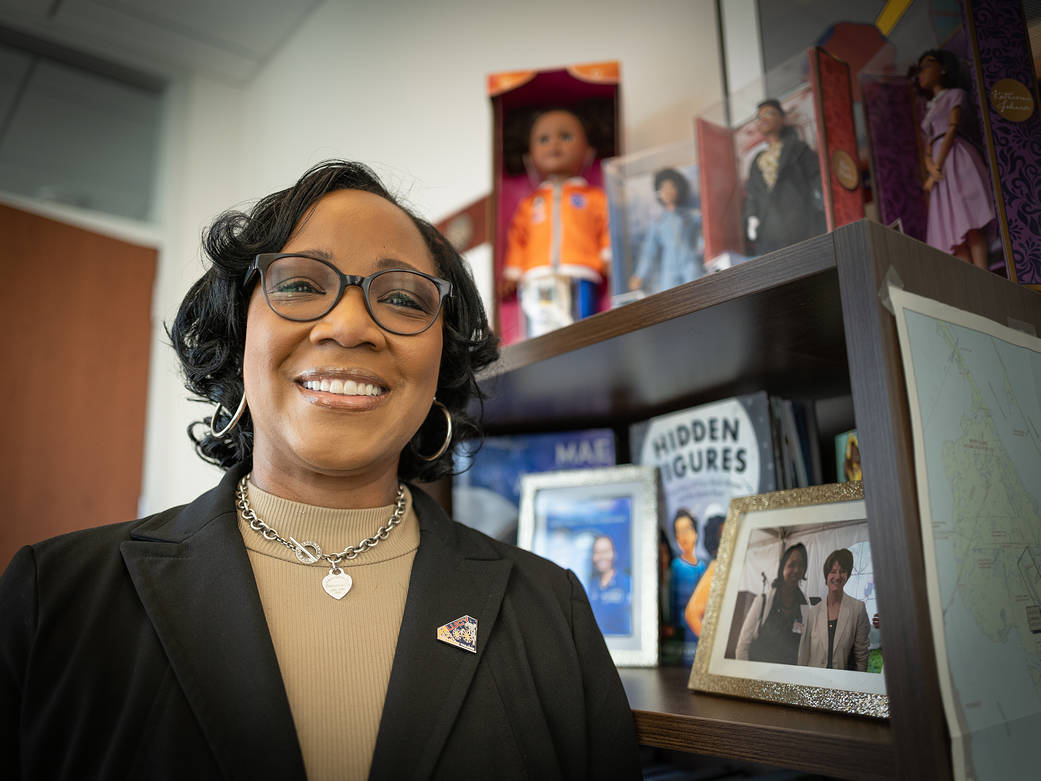Official Title: Project Manager for the Lucy Mission
Hometown: Salisbury, Maryland
Degrees Earned: B.S. of Mechanical Engineering from the University of Maryland, College Park
Donya Douglas-Bradshaw, project manager for the Lucy mission at NASA’s Goddard Space Flight Center in Greenbelt, Maryland, has a favorite quote that reads, “To whom much is given, much is required.” She explained, “That means if you have a gift, talent, or capabilities, it is your duty to use them for the betterment of society, your family, and yourself.”
Douglas-Bradshaw is busy overseeing the final preparations for the launch of NASA’s first mission to study the Trojan asteroids. Trojan asteroids are associated with Jupiter and comprise the same material that formed the outer planets of our solar system, such as Jupiter, Uranus, and Saturn.
She is responsible for ensuring accuracy of the technical details, budget, and schedule for the Lucy mission. Her primary job involves working with scientists, engineers, business managers, schedulers, and other experts to solve problems within budget and time constraints. Their goal is to build a spacecraft capable of traveling four billion miles to reach the Trojan asteroids.
“It’s about working with a team to find solutions to problems that enable us to make discoveries,” said Douglas-Bradshaw. “It’s always challenging, whether we are trying to extend a measurement or go further than we have ever before.”
Douglas-Bradshaw has worked at NASA for more than 30 years. She served eight months as Lucy’s deputy project manager before becoming the project manager. Prior to Lucy, she served as the project manager for the ATLAS instrument that flies aboard NASA’s ICESat-2 satellite.
Humble Beginnings
“I want to share my story because I think it’s important for people to see someone who came from a humble beginning living their passion,” Douglas-Bradshaw said.
Soon after she was born, her father joined the military and moved to California, leaving her mother, who worked as a cook, alone to raise two young girls.
Douglas-Bradshaw was raised on Maryland’s Eastern Shore in Salisbury, where she worked on farms picking cucumbers and tomatoes with her great-grandmother alongside migrant workers. That was one of the ways her family earned their living. For a while, her family lived at her great-grandmother’s house, which did not have indoor plumbing.
She recalled, “I always had a book in my hand. My dad was smart and loved science [so] he sent me books on science and engineering, spurring my interests.”
By the age of 10, Douglas-Bradshaw knew she wanted to work for NASA, and teachers saw her talents in math and science. She remembers many of her teachers fondly: her “no-nonsense” fifth-grade teacher, her high-school geometry teacher who inducted her into the National Honor Society, and her 12th-grade advanced-placement biology teacher, who she remembered as “tough and demanding, but showed compassion and empathy when needed.”
She earned a scholarship to Rutgers University in New Jersey, where she majored in mechanical engineering. “I did not see people who looked like me in science or engineering,” she said.
The summer before sophomore year, she became pregnant with twins and transferred to the University of Maryland Eastern Shore. Her boys were born prematurely at 28 weeks and spent their first four months in the hospital.
As a top student, Douglas-Bradshaw earned a one-year internship at NASA’s Wallops Flight Facility in Virginia. Afterward, she was offered a co-op position at Goddard. It was a position that allowed her to simultaneously work and attend school. She ultimately earned a degree in mechanical engineering from the University of Maryland at College Park in 1994.
At Goddard, colleagues say she’s good at setting priorities. “She can work with a little bit to make a lot,” said Amani Frazier, a system engineer at Goddard. “She’s not wasteful with time or resources.”
Douglas-Bradshaw places an especially high value on mentorship. She advocates for kids and has served on county and state groups for underrepresented youths. She advises students to advocate for themselves, but acknowledged, “In life and along your career path, you need people with authority to guide you.”
Facing and Overcoming Challenges
All project managers must plan for the unexpected. The Lucy mission is no different than others when it comes to challenges. But the Lucy team had an extra set of challenges brought on by the COVID-19 pandemic. “We had setbacks, and we had hardware challenges,” said Vince Elliott, Lucy’s deputy project manager of resources at Goddard.
On March 20, 2020, all work onsite at Goddard stopped for three months, including on Lucy’s L-Ralph instrument. L-Ralph carries a thermal spectrometer that uses heat to detect the chemicals on the surface of asteroids and another instrument to take color images of the asteroids to determine their composition.
Before the team could return to onsite work, new COVID-19 protocols had to be set. An innovative plan was needed to keep essential work moving forward with the necessary safety and social-distancing measures in place.
Douglas-Bradshaw and her team expanded the work week to allow for fewer people in the clean rooms at one time. She also increased the workforce and created isolated teams. “Early on, she gave clear rules of the road of how we were going to move forward,” said Elliott.
The separation made building and sustaining relationships more difficult, so she checked in with individuals regularly and encouraged her team to find a “work buddy” in which to share experiences. She also hosted virtual social events to maintain team morale, and it worked.
Douglas-Bradshaw and the Lucy team delivered the spacecraft to the launch site on time and within budget. That’s a testament to great leadership.
Lucy is scheduled to launch no earlier than 5:34 a.m. EDT Saturday, Oct. 16, on a United Launch Alliance (ULA) Atlas V 401 rocket from Space Launch Complex 41 at Cape Canaveral Space Force Station in Florida.
By Rani Gran
NASA’s Goddard Space Flight Center, Greenbelt, Md.



























